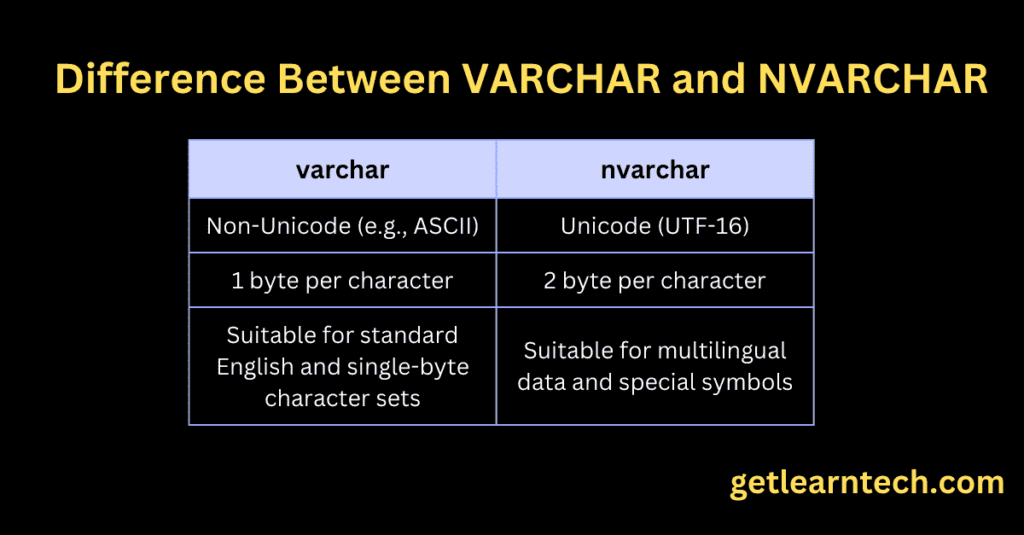
When designing a database, choosing the right data types is crucial for optimizing performance and ensuring compatibility with the data you need to store. Two commonly used data types for storing string data are VARCHAR and NVARCHAR. While they might seem similar, it is better to understand the key difference Between VARCHAR and NVARCHAR. The key differences that can impact your database’s efficiency and functionality. In this article, we will explore these differences and help you decide when to use VARCHAR vs. NVARCHAR.
Table of Contents
What is VARCHAR?
VARCHAR stands for Variable Character. It is used to store non-Unicode character data. This data type is ideal for storing standard English text and other languages that use single-byte character sets. Here are some key features of VARCHAR:
- Character Set: Uses the database’s default character set (such as ASCII).
- Storage: Stores characters using 1 byte per character.
- Efficiency: More storage-efficient for single-byte character sets.
- Usage: Suitable for applications where the text is limited to standard characters and symbols.
Example:
CREATE TABLE example (
name VARCHAR(100)
);
In this example, the name column can store up to 100 characters of non-Unicode text.
What is NVARCHAR?
NVARCHAR stands for National Variable Character. It is used to store Unicode character data, making it suitable for storing text in multiple languages, special symbols, and characters outside the ASCII range. Key features of NVARCHAR include:
- Character Set: Uses Unicode (UTF-16 in SQL Server).
- Storage: Requires 2 bytes per character (or more for certain characters).
- Usage: Ideal for storing multilingual data and special symbols.
- Compatibility: Ensures your database can handle diverse and complex character sets.
Example:
CREATE TABLE example (
name NVARCHAR(100)
);
In this example, the name column can store up to 100 Unicode characters.
What is the difference between VARCHAR and NVARCHAR
| Feature | VARCHAR | NVARCHAR |
|---|---|---|
| Character Set | Non-Unicode (e.g., ASCII) | Unicode (UTF-16) |
| Storage | 1 byte per character | 2 bytes per character (or more for certain Unicode characters) |
| Usage | Suitable for standard English and single-byte character sets | Suitable for multilingual data and special symbols |
| Storage Efficiency | More efficient for single-byte character sets | Requires more storage space |
| Collation and Sorting | Based on non-Unicode sorting rules | Based on Unicode sorting rules |
| Max Length | Depends on the database, e.g., up to 8000 characters in SQL Server | Up to 4000 characters in SQL Server (due to 2-byte storage per character) |
When to Use VARCHAR vs. NVARCHAR
Choosing between VARCHAR and NVARCHAR depends on your specific requirements:
Use VARCHAR when:
- You are storing text data limited to standard ASCII characters or single-byte character sets.
- Storage efficiency is important, and you do not need to support multiple languages or special symbols.
Use NVARCHAR when:
- You need to store text in multiple languages, including languages with complex characters like Chinese, Japanese, or Korean.
- You need to store special symbols, emojis, or any characters outside the standard ASCII range.
- Ensuring compatibility with diverse character sets is a priority.
Conclusion
Understanding the difference between VARCHAR and NVARCHAR is essential for database design and optimization. VARCHAR is suitable for standard character data with a focus on storage efficiency, while NVARCHAR is the best choice for applications that require robust support for multiple languages and special characters. By selecting the appropriate data type, you can ensure your database performs efficiently and meets the needs of your application.
Remember, choosing the right data type not only affects storage but also impacts performance and compatibility. Consider your specific use case and the nature of the data you are storing to make an informed decision between VARCHAR and NVARCHAR.
If you are preparing for Java interviews you can checkout here.

